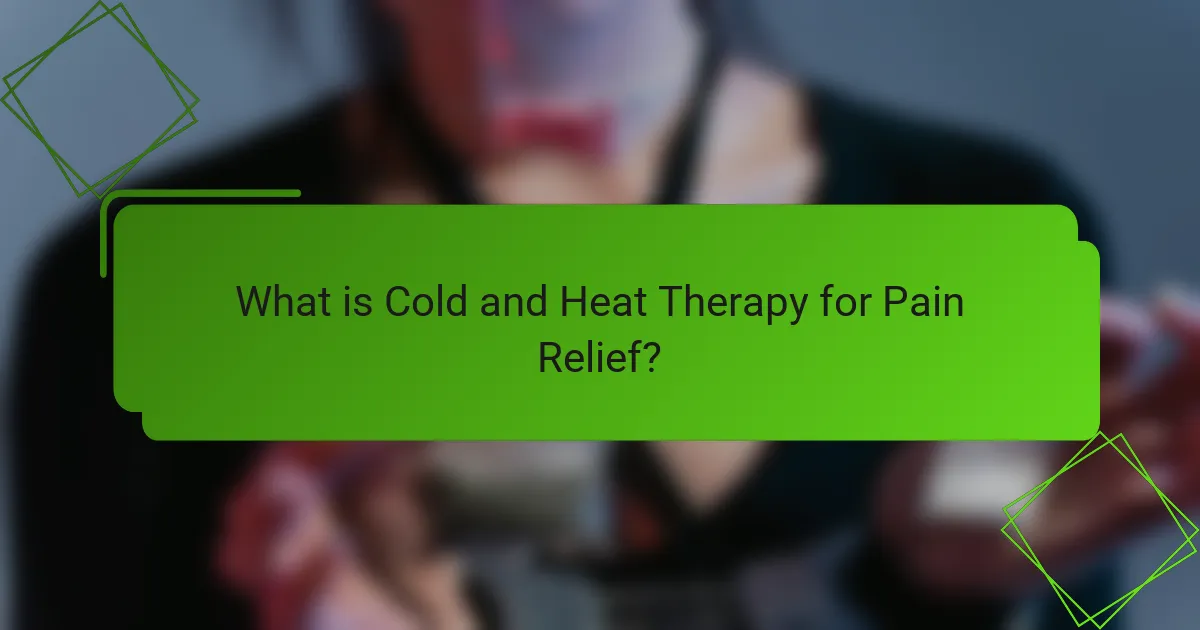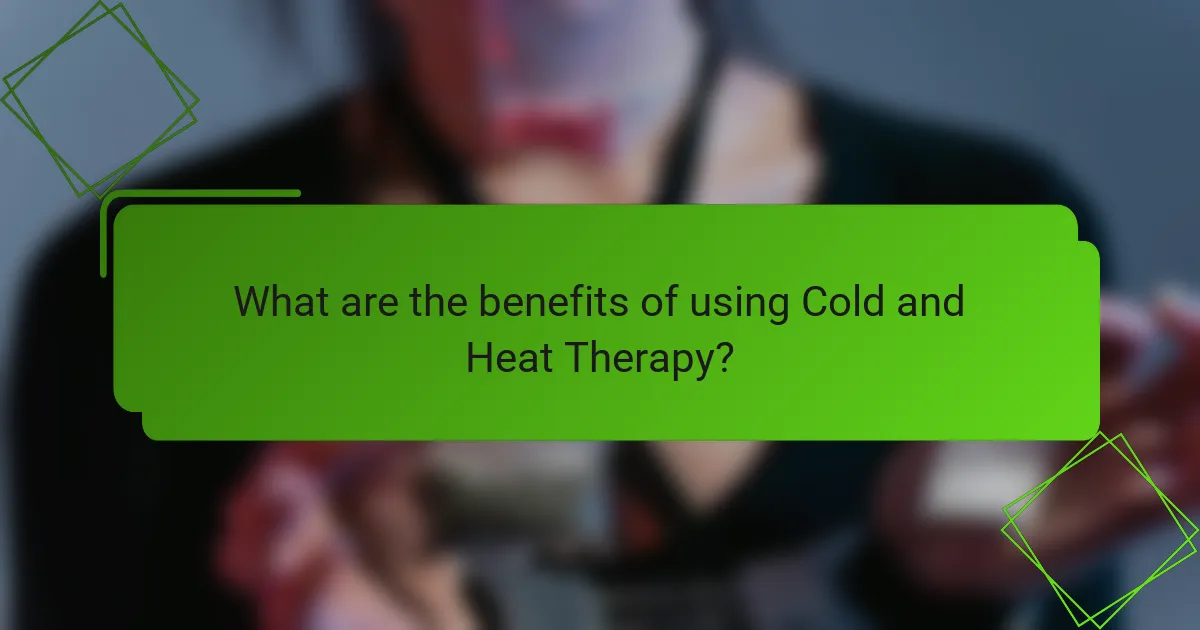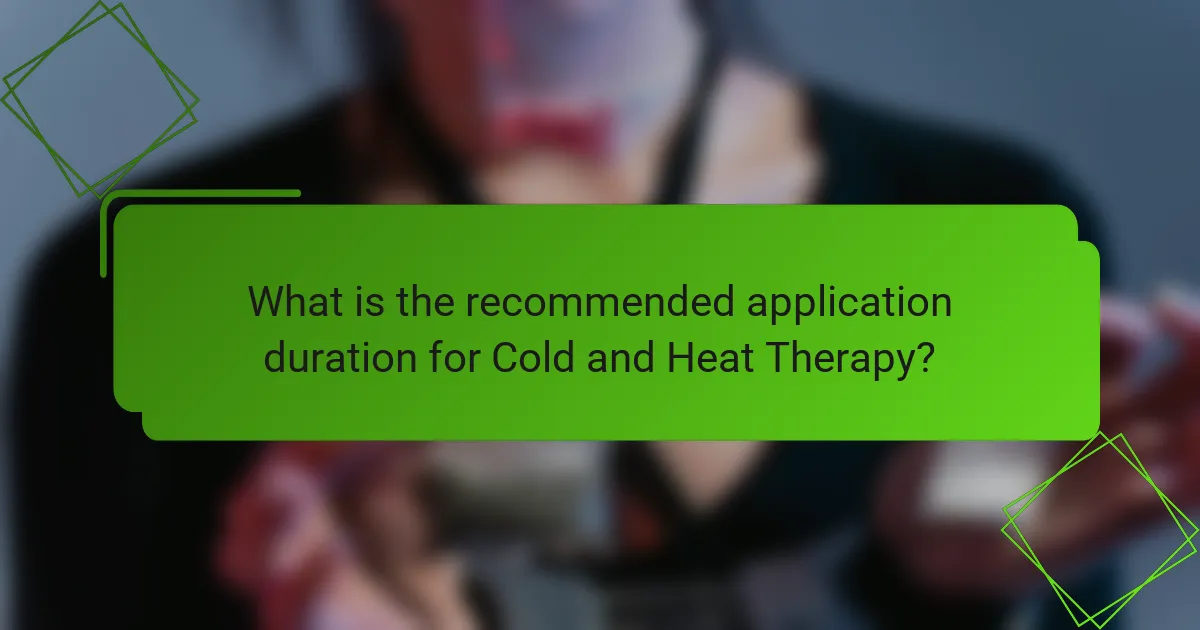
What is Cold and Heat Therapy for Pain Relief?
Cold and heat therapy are methods used for pain relief. Cold therapy, or cryotherapy, involves applying cold packs or ice to reduce inflammation and numb pain. It is effective for acute injuries and swelling. Heat therapy involves using heat packs or warm baths to relax muscles and improve blood flow. This method is beneficial for chronic pain and muscle stiffness. Both therapies can be applied for 15 to 20 minutes at a time. Research indicates that alternating between cold and heat can enhance pain relief and promote healing.
How do cold and heat therapies function in pain management?
Cold and heat therapies function in pain management by altering blood flow and affecting nerve signals. Cold therapy, or cryotherapy, reduces blood flow to the affected area. This decreases inflammation and numbs the pain. It is effective for acute injuries, such as sprains or strains. Heat therapy increases blood flow and relaxes muscles. This promotes healing and alleviates stiffness. It is beneficial for chronic pain conditions, like arthritis. Studies show that both therapies can significantly reduce pain levels. For instance, a study published in the Journal of Athletic Training found that cold therapy effectively reduced pain after acute injuries.
What physiological processes are influenced by cold therapy?
Cold therapy influences several physiological processes. It primarily reduces inflammation by constricting blood vessels. This vasoconstriction decreases blood flow to affected areas. Consequently, it minimizes swelling and tissue damage. Cold therapy also numbs nerve endings, providing pain relief. This effect can reduce muscle spasms and tension. Additionally, cold therapy can slow metabolic processes in tissues. This slowdown aids in reducing cellular activity and energy expenditure. Research indicates that cold therapy can enhance recovery after physical exertion. It is particularly effective in managing acute injuries and post-exercise soreness.
What physiological processes are influenced by heat therapy?
Heat therapy influences several physiological processes. It enhances blood circulation, which increases oxygen delivery to tissues. This process aids in the healing of injuries and reduces muscle stiffness. Heat therapy also promotes relaxation of muscles, leading to decreased pain and improved flexibility. Additionally, it can stimulate sensory receptors, which helps in pain relief. Studies indicate that heat application can elevate tissue temperature, which contributes to metabolic rate increases. This is supported by research from the Journal of Physical Therapy Science, showing improved muscle recovery with heat application. Overall, heat therapy effectively influences these physiological processes for pain relief and recovery.
What types of pain can be alleviated by cold and heat therapy?
Cold and heat therapy can alleviate various types of pain, including muscle pain, joint pain, and inflammation. Cold therapy is effective for acute injuries, such as sprains and strains, as it reduces swelling and numbs sharp pain. Heat therapy helps with chronic pain, like arthritis and muscle stiffness, by increasing blood flow and relaxing tight muscles. Studies show that cold therapy can significantly decrease pain intensity in sports injuries, while heat therapy improves mobility in patients with chronic conditions.
How does cold therapy help with acute injuries?
Cold therapy helps with acute injuries by reducing inflammation and numbing pain. The application of cold constricts blood vessels, which decreases blood flow to the injured area. This process minimizes swelling and helps prevent tissue damage. Cold therapy also slows down nerve conduction, leading to reduced pain sensation. Studies have shown that applying ice within the first 48 hours post-injury can significantly decrease recovery time. The American Academy of Orthopaedic Surgeons recommends cold therapy as a first-line treatment for acute injuries.
How does heat therapy assist in chronic pain conditions?
Heat therapy assists in chronic pain conditions by increasing blood flow and relaxing muscles. The application of heat dilates blood vessels, which enhances circulation. Improved circulation delivers oxygen and nutrients to affected areas. Heat also reduces muscle stiffness and alleviates spasms. This therapy can be applied through various methods, such as hot packs or warm baths. Research shows that heat therapy can significantly reduce pain levels in conditions like arthritis and lower back pain. A study published in the Journal of Pain Research found that heat therapy improved pain relief in patients with chronic pain conditions.

What are the benefits of using Cold and Heat Therapy?
Cold and heat therapy provide significant benefits for pain relief and recovery. Cold therapy reduces inflammation and numbs pain, which can be particularly effective for acute injuries. It constricts blood vessels, limiting blood flow to the affected area, thus decreasing swelling. Heat therapy, on the other hand, relaxes muscles and improves blood circulation. This can alleviate stiffness and promote healing in chronic pain conditions.
Research shows that cold therapy can lead to a 50% reduction in swelling in the first 48 hours post-injury. Heat therapy has been found to enhance flexibility and reduce muscle tension, making it beneficial for conditions like arthritis. Both therapies can be easily applied at home, making them accessible for ongoing pain management.
Why should one choose cold therapy over heat therapy?
Cold therapy is often preferred over heat therapy for acute injuries. Cold therapy reduces inflammation and numbs pain. It constricts blood vessels, which decreases swelling. This is particularly beneficial within the first 48 hours after an injury. Research indicates that applying ice can lessen tissue damage. A study published in the Journal of Athletic Training found that cold therapy effectively reduced pain and swelling in acute injuries. Cold therapy is also useful for conditions like sprains and strains. It helps to manage pain without the risk of increasing inflammation.
What are the primary advantages of cold therapy?
Cold therapy primarily reduces inflammation and swelling. It constricts blood vessels, decreasing blood flow to injured areas. This process minimizes tissue damage and alleviates pain. Cold therapy also numbs nerve endings, providing immediate pain relief. Studies show it is effective for acute injuries, such as sprains and strains. Additionally, it can help manage chronic pain conditions, like arthritis. Cold therapy can improve recovery times by reducing muscle soreness after exercise. Overall, it is a simple, cost-effective method for pain management.
In what scenarios is cold therapy most effective?
Cold therapy is most effective in reducing inflammation and numbing pain. It is commonly used immediately after injuries, such as sprains or strains. Cold therapy helps to constrict blood vessels, which reduces swelling. It is also beneficial for managing acute pain from conditions like tendonitis. Additionally, cold therapy can alleviate muscle soreness after intense exercise. It is effective in treating migraines by cooling the head and neck area. Cold therapy is often recommended for post-surgical recovery to minimize discomfort. Studies show that applying ice within the first 48 hours post-injury significantly aids in recovery.
What are the unique benefits of heat therapy?
Heat therapy provides unique benefits such as pain relief, improved circulation, and muscle relaxation. It alleviates muscle stiffness and promotes healing in soft tissues. Heat increases blood flow, delivering oxygen and nutrients to injured areas. This enhanced circulation aids in reducing inflammation and swelling. Additionally, heat therapy can enhance flexibility and range of motion. Research indicates that heat application can effectively reduce chronic pain conditions. A study published in the Journal of Pain Research found that heat therapy significantly improved pain levels in patients with musculoskeletal disorders.
How does heat therapy promote blood flow?
Heat therapy promotes blood flow by causing blood vessels to dilate. This dilation increases circulation in the targeted area. Improved circulation enhances oxygen and nutrient delivery to tissues. It also aids in the removal of metabolic waste. Studies show that applying heat increases skin temperature. For example, a study published in the Journal of Physical Therapy Science found that heat application significantly increased blood flow in muscle tissues. This effect can help reduce pain and promote healing in injured areas.
What conditions respond well to heat therapy?
Heat therapy is effective for various conditions. It helps alleviate muscle tension and soreness. Heat therapy also improves blood circulation. Conditions like arthritis respond positively to heat application. Chronic pain conditions, such as fibromyalgia, benefit from heat therapy. Additionally, heat can relieve menstrual cramps. It is also useful for lower back pain relief. Studies show heat therapy enhances healing in soft tissue injuries.

What is the recommended application duration for Cold and Heat Therapy?
The recommended application duration for cold therapy is typically 15 to 20 minutes. For heat therapy, the duration is generally the same, around 15 to 20 minutes. Both therapies should be applied with breaks in between to avoid skin damage. Cold therapy reduces inflammation and numbs pain, while heat therapy relaxes muscles and improves blood flow. These durations are supported by guidelines from medical sources such as the American Physical Therapy Association.
How long should cold therapy be applied for optimal results?
Cold therapy should be applied for 15 to 20 minutes for optimal results. This duration is effective for reducing inflammation and numbing pain. Applying cold therapy longer than this can risk skin damage and frostbite. Research indicates that repeated applications can be beneficial. However, each session should maintain the 15 to 20-minute guideline. This approach maximizes benefits while minimizing risks.
What are the guidelines for safe cold therapy application?
Apply cold therapy for 15 to 20 minutes at a time. Ensure a barrier, like a cloth, between the ice and skin. Repeat every 1 to 2 hours as needed. Monitor skin for signs of frostbite or irritation. Avoid cold therapy on areas with poor circulation or open wounds. Consult a healthcare professional if unsure about application. Research indicates that proper cold therapy reduces swelling and numbs pain effectively.
What signs indicate the need to stop cold therapy?
Signs that indicate the need to stop cold therapy include excessive pain, numbness, or tingling in the treated area. If the skin appears pale, blue, or feels unusually cold, therapy should be halted. Persistent swelling or increased stiffness can also signal a need to stop. Additionally, if there is a burning sensation or any signs of frostbite, cold therapy must be discontinued immediately. These signs indicate that the body is reacting negatively to the cold application. Monitoring these symptoms ensures safe and effective use of cold therapy.
How long should heat therapy be applied for effectiveness?
Heat therapy should be applied for 15 to 30 minutes for effectiveness. This duration allows sufficient time for the heat to penetrate the tissues and promote blood flow. Studies suggest that applying heat for this time frame can enhance muscle relaxation and reduce pain. Consistent application within this time range can lead to optimal therapeutic benefits. Using heat beyond 30 minutes may not provide additional advantages and could potentially cause skin irritation.
What are the best practices for heat therapy duration?
Heat therapy should typically be applied for 15 to 20 minutes at a time. This duration is effective for muscle relaxation and pain relief. Prolonged exposure can lead to skin irritation or burns. It is advisable to allow the skin to cool for at least 30 minutes before reapplying heat. Using a barrier, like a towel, can prevent direct contact and reduce the risk of burns. Research indicates that short, repeated applications are more beneficial than long sessions. The American Physical Therapy Association supports these guidelines for safe and effective use.
How can one avoid burns or overheating during heat therapy?
To avoid burns or overheating during heat therapy, use a barrier between the heat source and the skin. This can be a towel or cloth to prevent direct contact. Limit the duration of heat application to 15-20 minutes at a time. Check the skin regularly for any signs of redness or irritation. Adjust the temperature to a comfortable level before application. Avoid using heat therapy on areas with poor circulation or numbness. Always follow the manufacturer’s instructions for any heat therapy device. These practices help ensure safe and effective use of heat therapy.
What practical tips should be followed for effective Cold and Heat Therapy?
For effective cold and heat therapy, apply cold therapy within the first 48 hours of an injury. Use ice packs wrapped in a cloth for 15-20 minutes at a time. Repeat every hour as needed to reduce swelling and numb pain. For heat therapy, apply heat after 48 hours to relax muscles and improve blood flow. Use a heating pad or warm towel for 15-20 minutes. Ensure the temperature is comfortable to avoid burns. Always allow skin to cool down between applications. These practices are supported by research indicating that cold reduces inflammation while heat promotes healing.
Cold and heat therapy are prominent methods utilized for pain relief, each serving distinct physiological functions. Cold therapy, or cryotherapy, is effective in reducing inflammation and numbing pain for acute injuries, while heat therapy aids in muscle relaxation and enhances blood circulation for chronic pain conditions. The article details the mechanisms by which these therapies operate, the types of pain they alleviate, and the recommended application durations for optimal results. Additionally, it outlines practical tips for safe and effective use of both therapies, ensuring readers can implement these methods for pain management effectively.